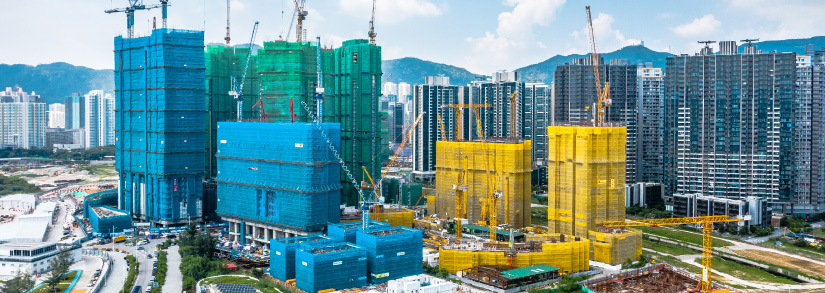
- During China’s latest round of COVID-19 lockdowns, credit spreads of USD Chinese high-yield corporate bonds widened dramatically, presenting both risks and opportunities for bond investors.
- Within high yield, the real estate sector experienced the largest spike in credit spreads, indicating continued difficulties for the sector.
- Potential investors in hard-currency high-yield Chinese corporate bonds may want to consider liquidity conditions before transacting, as estimated transaction costs and quoted-price uncertainty have spiked to exceptionally high levels.
Since the onset of property developer China Evergrande Group’s debt crisis, China’s real estate sector has been under pressure, causing concern for global investors. China’s fight against the latest wave of COVID-19 with renewed lockdowns also had a heavy economic impact.1 In light of these events, how has the country’s corporate-bond market responded?
Spiking credit spreads of Chinese high-yield corporate bonds
Credit spreads calculated by MSCI based on prices from S&P Global Market Intelligence. Bond credit ratings provided by Moody’s.
The exhibit above shows that in the eight months since October 2021, credit spreads of USD-denominated Chinese high-yield corporate bonds widened dramatically,2 presenting both risks and opportunities for bond investors. Credit spreads spiked to the highest level for the real estate sector,3 which makes up 59% of all outstanding debt within this group.4 This may have indicated an increased risk of default for investors holding these bonds, but also an opportunity for investors expecting prices to rebound.
Number of dealers quoting Chinese corporate bonds
Source: S&P Global Market Intelligence, Moody’s
Quoted-price uncertainty spiked for real estate and financial issuers
Source: S&P Global Market Intelligence, Moody’s
The top panel in the exhibit above shows that the number of dealers quoting these bonds has remained relatively stable, indicating that there was little impact on market accessibility for institutional investors. However, dealers had difficulties pricing these bonds, as shown by the higher levels of quoted-price uncertainty in the lower panel.5 For the real estate and financial sectors within USD Chinese high-yield corporate bonds, quoted-price uncertainty spiked to exceptionally high levels, surpassing the peak of the 2020 COVID outbreak.
The impact on liquidity
How is this uncertainty reflected in bond liquidity? Institutional investors may have faced increased liquidity risk when buying or selling these bonds. We used MSCI’s RiskMetrics® LiquidityMetrics® to estimate the transaction costs for trading USD 5 million notional within one day. The cost estimates for a typical bond within each group can be seen in the interactive exhibit below.6
Our methodology breaks transaction costs down into bid-ask spread and market impact.7 The market impact, which is the additional cost above the half bid-ask spread, measures the impact of larger trades on transaction prices.
Rising transaction costs for real estate and financials
This chart uses MSCI analytics based on data provided by S&P Global Market Intelligence and Moody’s bond ratings.
For high-yield Chinese real estate bonds, estimated transaction costs peaked at around 700 basis points, surpassing levels seen during the COVID-19 outbreak of 2020. Transaction costs also increased for other sectors, showing how liquidity was affected for the Chinese high-yield USD corporate bond market.
A clearer view of liquidity risk
Widening credit spreads in USD high-yield Chinese corporate bonds and transaction costs spiking to historically high levels should prompt institutional investors to consider liquidity when assessing the overall risk profile of these bonds.
1Hale, Thomas, and Creery, Jennifer. “China’s economic activity plummets as Covid lockdowns hit growth.” Financial Times, May 16, 2022.
2Within Chinese hard-currency corporate bonds, we restricted our analysis to USD-denominated bonds, as they make up 97% of all outstanding debt.
3Average credit spread weighted by outstanding amount.
4Based on outstanding amount within USD Chinese high-yield corporate bonds, as of June 20, 2022. Based on Moody’s bond credit ratings.
5The quoted-price uncertainty of a bond is defined as the daily standard deviation of the quoted price divided by the average quoted price. It is a measure of the relative dispersion of quoted prices.
6Knipl, Diana, Bohak, Andras, and Hollo, Laszlo. 2019. “Integrating Trade and Quote Market Data into Fixed Income Liquidity Research.” MSCI Model Insight.
7The bid-ask spread is the roundtrip cost of buying and selling a given security. We assume that half of it may be attributed to the buying and the other half to the selling of the bond. The market impact is the extra cost above the half bid-ask spread, which is incurred for trades larger than the typical quote size.
Further Reading
After Evergrande: Bond Liquidity of Chinese Property Developers
Liquidity and correlation in the Chinese credit market
